Mosaic of Peace, Day 5

Dark Pink: Area A (Israel bans Israelis’ entry)
Light Pink: Area B (Mixed control).
Yellow: Area C (Full Occupation).
Blue: Israeli Settlements (High Security).
Purple: Future Settlements.
After three and a half days staying in and exploring the Old City area of Jerusalem, yesterday we took a bus tour of East Jerusalem with an Israeli guide named Yaniv Mazor—a former tank commander in the IDF who, after serving three years of mandatory service, cut short his time serving in the reserve (and faced several weeks of military prison) because of his perception that the situation in Israel-Palestine was systematically oppressive. I think it is important to include this background because every perspective includes its own biases—as he himself acknowledged.
___________________________________________
“The real walls are in our mind…the physical wall is just a symbol of that.”
—Yaniv Mazor
___________________________________________
It was Yaniv, an Israeli citizen, who drew an analogy between the issue of gerrymandering in the US and the placement of the barrier surrounding the annexed (occupied) portions of East Jerusalem. To his mind, its placement is not used to maximize security, but rather to justify Israel’s annexation of the eastern portion of the city—balancing including enough Palestinian areas (within the municipal area) to include the whole city against the need to keep the number of Palestinians low enough for a significant Jewish numerical superiority, in order to justify the annexation. Israel frames the East Jerusalem occupation as the “reunification” of the city, though what it means for Palestinians is a split in their community…in the form of a meandering wall.

Looking at a map of current wall sections, the wall dips into and out of Area C of the Oslo Accords—not just to cover settlements, but also to divide Palestinian villages from each other and from their farmland. (“Planned sections” on the map make this even more extreme). In some locations, the barrier wall separates Israeli settlements from Palestinian neighborhoods, excluding the latter from residence in Jerusalem (and from participation in municipal elections). Palestinian residents of these areas need to apply for permission to work in the city with a system which our guide described as “Kafkaesque”. Others are split down the middle, separating homesteads from farms. Meanwhile, some nearby Israeli settlements are also outside the city and have their own walls. These settlements have access to lower-security entrance to Jerusalem, with Israeli citizens obviously not needing to apply for work permits.
Within the city’s jurisdiction, Mr. Mazor also emphasized the discrepancies in infrastructure…from inconsistent power supply in Palestinian neighborhoods, to low water pressure that reveals itself in the iconic black tanks used as an attempt to compensate, to an inadequate system of roads. (At one point, this was underscored by a municipal bus needing to back up several hundred yards to allow space for our tour bus to squeeze past.) In stark contrast, Israeli settlements in East Jerusalem and the West Bank have plenty of infrastructure, supported by government subsidies. In part due to these subsidies, the settlements have a low cost of living relative to West Jerusalem—a situation which has led about 200,000 Israeli settlers to inhabit East Jerusalem.
___________________________________________
The military law imposed by Israel on Palestinians, varying based on the Zone A, B, and C designations of the Oslo Accords, depends on the Geneva Conventions rules for a “temporary occupation”. So, if the land is now “disputed territory” being claimed by Israel for settlements, then the military control is not really covered by international law.
___________________________________________
In terms of international law, the Israeli justification rests on a clever bit of deliberate vagueness—explained to us by members of Military Court Watch (MCW), a team of lawyers from around the world that monitors the treatment of prisoners in the first 48 hours after arrest. (Human rights violations are most likely to occur within these first two days). As MCW explained, the majority of the West Bank and Gaza is under martial law…legally. Instating martial law, Israel correctly cited the Geneva convention, which includes martial law as part of a temporary occupation.
Here’s the catch: that section of the convention also prohibits the occupier from settling/colonizing. So, in order to justify settlements in the West Bank and East Jerusalem, Israel rests its case on declaring them “disputed territory” instead of “occupied territory.” But remember: the military law imposed by Israel on Palestinians, varying based on the Zone A, B, and C designations of the Oslo Accords, depends on the Geneva Conventions rules for a “temporary occupation”. So, if the land is now “disputed territory” being claimed by Israel for settlements, then the military control is not really covered by international law.
___________________________________________
When we asked Yaniv whether or not it was illegal to talk about this kind of stuff—and/or the BDS movement—in Israel, he replied: “Not yet.”
___________________________________________
Yaniv said one more thing that still resonates with me. After suggesting that the aggressive military strategy of the IDF (which, remember, he once participated in first-hand) has done more to increase security than the border wall, he told us that “The real walls are in our mind…the physical wall is just a symbol of that.”
When we asked Yaniv whether or not it was illegal to talk about this kind of stuff—and/or the BDS movement—in Israel, he replied: “Not yet.”
He did not seem optimistic, though: legislation has already been introduced in the Knesset to punish BDS through lawsuits without proof of damages.
***
The Mosaic of Peace trip is part of the ministry of the Presbyterian Peace Program. It brings members and partners of the PC(USA) from a variety of backgrounds to Israel-Palestine in order to “experience this remarkable and troubled region, encounter its diverse people, explore its rich history and complex current situation, and engage with those who seek its peace.”
This blog entry was contributed by Henry Koenig Stone, as part of our effort to bring back and share the stories of Mosaic of Peace 2018. The full blog is co-hosted by Unbound and by the Presbyterian Peacemaking Program.





Unbound Social